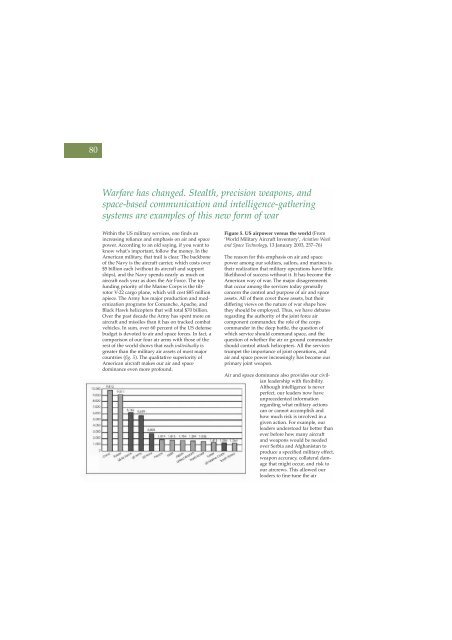Volume 6 No 4 - Royal Air Force Centre for Air Power Studies
Volume 6 No 4 - Royal Air Force Centre for Air Power Studies
Volume 6 No 4 - Royal Air Force Centre for Air Power Studies
You also want an ePaper? Increase the reach of your titles
YUMPU automatically turns print PDFs into web optimized ePapers that Google loves.
80<br />
Warfare has changed. Stealth, precision weapons, and<br />
space-based communication and intelligence-gathering<br />
systems are examples of this new <strong>for</strong>m of war<br />
Within the US military services, one finds an<br />
increasing reliance and emphasis on air and space<br />
power. According to an old saying, if you want to<br />
know what’s important, follow the money. In the<br />
American military, that trail is clear. The backbone<br />
of the Navy is the aircraft carrier, which costs over<br />
$5 billion each (without its aircraft and support<br />
ships), and the Navy spends nearly as much on<br />
aircraft each year as does the <strong>Air</strong> <strong>Force</strong>. The top<br />
funding priority of the Marine Corps is the tiltrotor<br />
V-22 cargo plane, which will cost $85 million<br />
apiece. The Army has major production and modernization<br />
programs <strong>for</strong> Comanche, Apache, and<br />
Black Hawk helicopters that will total $70 billion.<br />
Over the past decade the Army has spent more on<br />
aircraft and missiles than it has on tracked combat<br />
vehicles. In sum, over 60 percent of the US defense<br />
budget is devoted to air and space <strong>for</strong>ces. In fact, a<br />
comparison of our four air arms with those of the<br />
rest of the world shows that each individually is<br />
greater than the military air assets of most major<br />
countries (fig. 5). The qualitative superiority of<br />
American aircraft makes our air and space<br />
dominance even more profound.<br />
Figure 5. US airpower versus the world (From<br />
‘World Military <strong>Air</strong>craft Inventory’, Aviation Week<br />
and Space Technology, 13 January 2003, 257–76)<br />
The reason <strong>for</strong> this emphasis on air and space<br />
power among our soldiers, sailors, and marines is<br />
their realization that military operations have little<br />
likelihood of success without it. It has become the<br />
American way of war. The major disagreements<br />
that occur among the services today generally<br />
concern the control and purpose of air and space<br />
assets. All of them covet those assets, but their<br />
differing views on the nature of war shape how<br />
they should be employed. Thus, we have debates<br />
regarding the authority of the joint <strong>for</strong>ce air<br />
component commander, the role of the corps<br />
commander in the deep battle, the question of<br />
which service should command space, and the<br />
question of whether the air or ground commander<br />
should control attack helicopters. All the services<br />
trumpet the importance of joint operations, and<br />
air and space power increasingly has become our<br />
primary joint weapon.<br />
<strong>Air</strong> and space dominance also provides our civilian<br />
leadership with flexibility.<br />
Although intelligence is never<br />
perfect, our leaders now have<br />
unprecedented in<strong>for</strong>mation<br />
regarding what military actions<br />
can or cannot accomplish and<br />
how much risk is involved in a<br />
given action. For example, our<br />
leaders understood far better than<br />
ever be<strong>for</strong>e how many aircraft<br />
and weapons would be needed<br />
over Serbia and Afghanistan to<br />
produce a specified military effect,<br />
weapon accuracy, collateral damage<br />
that might occur, and risk to<br />
our aircrews. This allowed our<br />
leaders to fine-tune the air
















